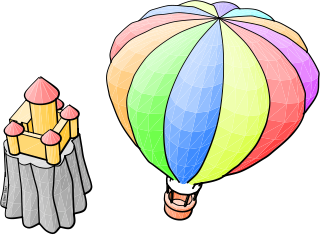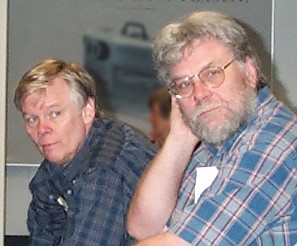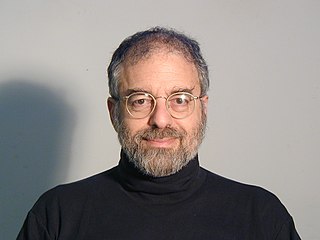Related Research Articles

A computer program is a sequence or set of instructions in a programming language for a computer to execute. Computer programs are one component of software, which also includes documentation and other intangible components.
In artificial intelligence, an expert system is a computer system emulating the decision-making ability of a human expert. Expert systems are designed to solve complex problems by reasoning through bodies of knowledge, represented mainly as if–then rules rather than through conventional procedural code. The first expert systems were created in the 1970s and then proliferated in the 1980s. Expert systems were among the first truly successful forms of artificial intelligence (AI) software. An expert system is divided into two subsystems: the inference engine and the knowledge base. The knowledge base represents facts and rules. The inference engine applies the rules to the known facts to deduce new facts. Inference engines can also include explanation and debugging abilities.

Frederick Phillips Brooks Jr. was an American computer architect, software engineer, and computer scientist, best known for managing the development of IBM's System/360 family of computers and the OS/360 software support package, then later writing candidly about those experiences in his seminal book The Mythical Man-Month.

Smalltalk is a purely object oriented programming language (OOP), created in the 1970s for educational use, specifically for constructionist learning, at Xerox PARC by Learning Research Group (LRG) scientists, including Alan Kay, Dan Ingalls, Adele Goldberg, Ted Kaehler, Diana Merry, and Scott Wallace.

Virtual reality (VR) is a simulated experience that employs pose tracking and 3D near-eye displays to give the user an immersive feel of a virtual world. Applications of virtual reality include entertainment, education and business. Other distinct types of VR-style technology include augmented reality and mixed reality, sometimes referred to as extended reality or XR, although definitions are currently changing due to the nascence of the industry.

Xenix is a discontinued version of the Unix operating system for various microcomputer platforms, licensed by Microsoft from AT&T Corporation in the late 1970s. The Santa Cruz Operation (SCO) later acquired exclusive rights to the software, and eventually replaced it with SCO UNIX.

Augmented reality (AR) is an interactive experience that combines the real world and computer-generated content. The content can span multiple sensory modalities, including visual, auditory, haptic, somatosensory and olfactory. AR can be defined as a system that incorporates three basic features: a combination of real and virtual worlds, real-time interaction, and accurate 3D registration of virtual and real objects. The overlaid sensory information can be constructive, or destructive. This experience is seamlessly interwoven with the physical world such that it is perceived as an immersive aspect of the real environment. In this way, augmented reality alters one's ongoing perception of a real-world environment, whereas virtual reality completely replaces the user's real-world environment with a simulated one.

Ben Shneiderman is an American computer scientist, a Distinguished University Professor in the University of Maryland Department of Computer Science, which is part of the University of Maryland College of Computer, Mathematical, and Natural Sciences at the University of Maryland, College Park, and the founding director (1983-2000) of the University of Maryland Human-Computer Interaction Lab. He conducted fundamental research in the field of human–computer interaction, developing new ideas, methods, and tools such as the direct manipulation interface, and his eight rules of design.

Myron Krueger is an American computer artist who developed early interactive works. He is also considered to be one of the first generation virtual reality and augmented reality researchers.

Brenda Laurel is an American interaction designer, video game designer, and researcher. She is an advocate for diversity and inclusiveness in video games, a "pioneer in developing virtual reality", a public speaker, and an academic.
In the mid-1970s, Myron Krueger established an artificial reality laboratory called the Videoplace. His idea with the Videoplace was the creation of an artificial reality that surrounded the users, and responded to their movements and actions, without being encumbered by the use of goggles or gloves. The work done in the lab would form the basis of his much cited 1983 book Artificial Reality. The Videoplace, was the culmination of several iterations of artificial reality systems: GLOWFLOW, METAPLAY, and PSYCHIC SPACE; each offering improvements over the previous installation until VIDEOPLACE was a full blown artificial reality lab at the University of Connecticut.

Daniel J. Sandin is an American video and computer graphics artist, designer and researcher. He is a Professor Emeritus of the School of Art & Design at University of Illinois at Chicago, and co-director of the Electronic Visualization Laboratory (EVL) at the University of Illinois at Chicago. He is an internationally recognized pioneer in computer graphics, electronic art and visualization.
Elliot Bruce Koffman is a noted computer scientist and educationist. He is the author of numerous widely used introductory textbooks for more than 10 different programming languages, including Ada, BASIC, C, C++, FORTRAN, Java, Modula-2, and Pascal. Since 1974, he has been a professor of computer and information sciences at Temple University, Philadelphia, Pennsylvania.

Virtual art is a term for the virtualization of art, made with the technical media developed at the end of the 1980s. These include human-machine interfaces such as visualization casks, stereoscopic spectacles and screens, digital painting and sculpture, generators of three-dimensional sound, data gloves, data clothes, position sensors, tactile and power feed-back systems, etc. As virtual art covers such a wide array of mediums it is a catch-all term for specific focuses within it. Much contemporary art has become, in Frank Popper's terms, virtualized.

Immersion into virtual reality (VR) is a perception of being physically present in a non-physical world. The perception is created by surrounding the user of the VR system in images, sound or other stimuli that provide an engrossing total environment.
A projection augmented model is an element sometimes employed in virtual reality systems. It consists of a physical three-dimensional model onto which a computer image is projected to create a realistic looking object. Importantly, the physical model is the same geometric shape as the object that the PA model depicts.

Aaron Marcus is an American user-interface and information-visualization designer, as well as a computer graphics artist.
In computing, 3D interaction is a form of human-machine interaction where users are able to move and perform interaction in 3D space. Both human and machine process information where the physical position of elements in the 3D space is relevant.

Computer-generated imagery (CGI) is a specific technology or application of computer graphics for creating or improving images in art, printed media, simulators, videos and video games. These images are either static or dynamic. CGI both refers to 2D computer graphics and 3D computer graphics with the purpose of designing characters, virtual worlds, or scenes and special effects. The application of CGI for creating/improving animations is called computer animation, or CGI animation.
Ulrike Gabriel was born in 1964 in Munich and is an artist and researcher focussing on generative systems. Ulrike co-founded the laboratory Codelab, Berlin where she spent some time as a director. She also worked in ecological agriculture in Argentina from 2003 to 2006. Ulrike was also a professor at the University of Art and Design HfG Offenbach (2006-2012). At this university, she led the teaching area of Electronic Media. She studied philosophy at the Ludwig Maximilian University from 1983–1985 and painting and applied graphics at the Academy of Fine Arts from 1985-1991 in Munich. After that she was a post-graduate at the Institute for New Media at the Städelschule, Frankfurt (1991-1992) and a research fellow at the Academy of Media Arts Cologne, department for media science (1996-1998).
References
- ↑ Krueger, Myron W. (1985). ""VIDEOPLACE": A Report from the ARTIFICIAL REALITY Laboratory". Leonardo. 18 (3): 145–151. doi:10.2307/1578043. ISSN 0024-094X. JSTOR 1578043. S2CID 62030583.
- ↑ Erickson, Thomas (1993-01-01), Wexelblat, ALAN (ed.), "Chapter 1 - Artificial Realities as Data Visualization Environments: Problems and Prospects", Virtual Reality, Academic Press, pp. 3–22, ISBN 978-0-12-745045-2 , retrieved 2020-11-24